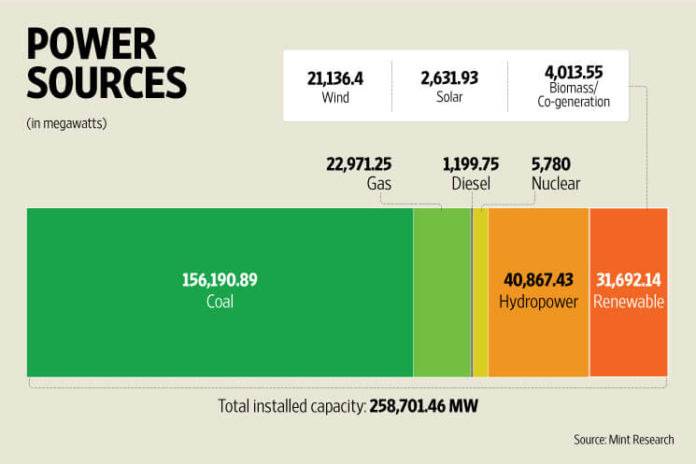There is a revolution underway in India’s energy sector, with renewable becoming cheaper than coal. Shortly, at least two states in India are likely to generate all the power they need from renewable sources. More than anything else, the Modi government is planning to make all vehicles 100 per cent electric powered by 2030.
By Narayan Ammachchi
For decades, countries around the world believed that cutting carbon emission and dumping cheap coal for expensive renewable energy resources would hurt their economic growth. But India, for the first time, has proved them wrong.
India is adding 50 per cent more solar and wind than the U.S. currently has installed. Alongside increasing its energy stockpile, the country is giving electrifying its villages, some of which had no access to power even the 21st century. In addition, the country has remained the fastest growing economy in the world, overtaking China.
“Everything changed in 2015 with the Paris climate agreement. We must decouple economic growth from environmental impacts and leave a better world,” said Piyush Goyal, Energy Minister, in Vienna Energy Forum earlier in May. “Every moment counts,” he added, as the country changed from “energy-deficient country” to “energy-surplus country.”
India’s record investment in green energy has delighted Tuvalu, a tiny island in the Pacific, which is barely ten feet above the sea level and rising water levels, resulting from climate change, have forced thousands to leave the country already.
“I’ve never heard such visionary and progressive remarks from a world-leading country,” the Prime Minister of Tuvalu, Enele Sopoaga, reacted to global media.
Interestingly, India’s green energy initiatives are not only easing its energy shortage but also creating a lot of jobs, in addition to helping industries bloom.
Remember, India has already begun replacing 770 million street and household lights with energy-saving and long-lasting LEDs and bringing electric access for the first time to tens of thousands of poor rural villages. And the country is already doing all of this faster than anyone believed possible.
The previous government had insisted on using coal to develop its economy, just as China had done 25 years ago. But now prime minister Narendra Modi is trying to hitch India’s future to 21st-century technologies.
The energy savings from replacing 770 million household and streetlights alone will cut India’s peak electricity demand by 20,000 megawatts (MW) and slash emissions of climate-heating CO2 by nearly 80 million tonnes annually, according to National Geographic Magazine.
That’s almost as much as Chile’s CO2 emissions in 2015. This drastically reduces the need to build more energy plants and will save thousands of crores of rupees a year. And all of this has been accomplished without government funding.
Good beginning
Three years ago, the government set up a company called Energy Efficiency Services Limited, which has been making profit ever since its inception. This company has worked with LED manufacturers to drive the costs of these lights down 85 per cent in less than three years. As a result, more and more people are buying LED bulbs and saving power.
Every country, including the United States, is adopting LED bulbs, but the speed at which India is replacing is just astounding. In Washington, D.C., for example, 71,000 streetlights may be replaced under the Streetlight Modernization Project, but it will only start in 2018.
Solar Revolution
India’s renewable energy sector is also growing at lightning speed. India has promised to add 160 gigawatts (GW) of wind and solar by 2022 to the existing 26 GW. The U.S. currently has just over 100 GW in total. One GW can power 100 million LED lightbulbs used in homes.
Meanwhile, wind energy projects have been hugely successful in Tamil Nadu, Maharastra, Rajasthan and Gujarat. The heavy investment has pushed down the prices of renewable energy so much that today solar and wind power is cheaper than coal in India.
“Green energy is no longer expensive or difficult to build and it is well-suited to our needs,” said Goyal. Given all the benefits, every country should be taking the same path, he said.
Goyal has repeatedly stated that he would make sure that every household is connected to the electric grid by 2019, three years before India’s 2022 target set by Prime Minister Modi.
“India’s energy revolution may soon transform the country but it is also creating “solutions that other countries across the world can replicate and use to support their own sustainable energy transition,” said Rachel Kyte, CEO for Sustainable Energy for All and Special Representative of the UN Secretary-General, according to National Geographic.
Box-Item
Rise of Electric Cars
To reduce its dependency on oil from Arab countries, India’s is laying the groundwork to popularize electric cars. In May, the government commissioned a study on how the country’s entire fleet of vehicles could be 100 per cent electric powered by 2030.
The plan is to make sure that electric cars are the only vehicles sold because of low operating costs, little maintenance or repairs needed, along with a long life.
“The batteries will also work very well with solar and wind as energy storage devices. No subsidies will be needed,” Goyal said in the interview with National Geographic.
Recently, Niti Ayog has recommended lowering taxes and interest rates for loans on electric vehicles, while capping sales of conventional cars.
It has also suggested the opening of a battery plant by the end of 2018 and using tax revenues from the sale of petrol and diesel vehicles to set up charging stations for electric vehicles.
Today, Mahindra & Mahindra is the only manufacturer of electric vehicles in India. But, with the government’s push, more and more automakers will introduce electric cars to the market.
The think-tank has asked the government to limit registration of conventional vehicles and giver preference to the registration for electric vehicles, similar to that in China.
Among its suggestions include incentivising the use of electric cars by lowering taxes, interest rates on loans for purchases and electricity tariffs for fleet operators, and lowering duties on makers of such fleet cars.












